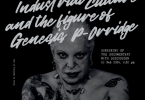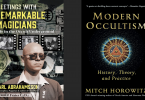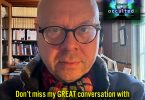It would be so wonderful to have the time to actually A) read some new books and B) write about them in depth. But until that moment comes, I’ll have to make do with C) a superficial overview. I’m just very happy that there are so many interesting books coming out, and if you hadn’t seen or heard of any of these titles before, then I’ve definitely acquired some good book lover/publisher karma.
A.J. Lees: Mentored by a Madman – The William Burroughs Experiment (Notting Hill Editions, 2016)
The back side copy text of this book is so to the point I’ll just use that here: “A fascinating personal account by one of the world’s leading neurologists on the profound influence of William Burroughs on his medical career. Lees relates how Burroughs, author of Naked Lunch and troubled drug addict, inspired him to discover a ground-breaking treatment for Parkinson’s Disease. Lees journeys to the Amazonian rainforests in search of cures, and through creative thinking and self-experimentation, seeks to find the answers his patients crave. He enters a powerful plea against bureaucracy, and calls for the return of freedom and imagination to medical research.”
Gordon White: Star.Ships (Scarlet Imprint, 2016)
Gordon White is a very intelligent surfer on a new wave of thinking that used to be “arcanely contained”, i.e. belonging in the sphere of magic and occultism. Things are developing quickly in this sphere, and White is an important contributor to a well needed modernisation of esoteric thought. Again, the book blurb probably conveys it best: “A defining text of the new magical renaissance, Star.Ships addresses the question of who we are now by tracing where we come from, and by drawing out the stories and the spirits that have journeyed and evolved with us. The goal is, as Gordon writes, the restoration of context. To this end, White applies his globally-recognised data and demographics skills to realise a groundbreaking work of truly interdisciplinary research. Utilising mythological, linguistic and astronomical data to reconstruct palaeolithic magical beliefs, he maps them to the human journey out of Africa; explores which aspects of these beliefs and practices have survived into the Western tradition; and what the implications (and applications) of those survivals may be for us. Written for a magically literate and operative audience, Star.Ships displays the flair, wit and engagement with evidence that adherents of his runesoup blog have come to expect from Gordon. He deftly handles vast time scales and cosmologies to build his case; avoids the pitfalls of alternative historians with a refreshing absence of dogma or wishful thinking; and, in a masterful deployment of the latest research, simultaneously questions outworn dominant narratives and is not afraid to champion the work of independent researchers and entertain forbidden discourses. It is exactly what chaos magic should be. Göbekli Tepe, the Pyramids and Sphinx, Nabta Playa, Gunung Padang, Easter Island and Sundaland are some of the points spangled across a work of truly cosmic scope. Star.Ships beckons those who are willing to engage in the adventure to follow the great river of history that flows into and out of an ocean of stars. Minds will be blown.”
David Chaim Smith: The Awakening Ground – A Guide to Contemplative Mysticism (Inner Traditions, 2016)
Well, this I would call a must have book. And one I intend to return to in depth. I think most people mainly associate David Chaim Smith with his beautiful and intricate visual cabalistic vistas, but this is something else. It’s his own story of awakening to what’s behind the scenes of symbol-heavy old texts. Which makes it valid and relevant for a general “occult” audience too. Information, as we all know, can be ingested ad infinitum, but it serves no purpose (higher or lower) if the process doesn’t allow for insights and genuine wisdom to flow through and take hold. Smith calls this “awakenings”, and that’s indeed a very apt term. As usual, his images are incredibly beautiful, and it’s totally possible to see how his manifestation of them helped him delve deeper/higher on his own path. That’s not saying you have to be a skilled master artist to “get” any kind of bigger/inner picture, but the devotion certainly helps. You may file this under “Cabala” and “great art”, but make sure you actually use it in inspirational ways – whichever tradition you’re coming from.
Gary Lachman: Secret Teachers of the Western World (Tarcher Penguin, 2015)
This is actually a book I have read from beginning to end. There is a reason for that: Gary Lachman is a great writer. He also has a mind that enables a structured retelling of complex human stories, destinies and related external cultural shifts. This book presents an overview of people and ideas that have helped shape the world we live in, quite often in non-linear and anachronistic ways. Creators and thinkers like Pythagoras, Aristotle, Plato, Theophilus, Dionysius the Areopagite, Dante, Pico della Mirandola, Christian Rosencreuz, Roger Bacon, Emmanuel Swedenborg and many others (and also on to the present day) are exposed and elaborated upon in a suave and engaging fashion, very much like Lachman’s mentor (and current book focus) Colin Wilson. The book works as an eye-opening introduction as well as a scholarly replenishment in the study of human intelligence. Lachman is a wonderful synthesiser and condenser, and this overview is without a doubt his best book so far (I have yet to finish his Colin Wilson biography: Beyond the Robot). More publisher copy: “This epic study unveils the esoteric masters who have covertly impacted the intellectual development of the West, from Pythagoras and Zoroaster to the modern icons Jean Gebser and Schwaller de Lubicz.”
I would also like to point out that the new issue of The Fenris Wolf contains the text of a lecture by Lachman on this very same subject. That book can be ordered here!
Joanna Ebenstein: The Anatomical Venus – Wax, God, Death & The Ecstatic (Morbid Anatomy, 2016)
This must surely be one of the best book titles ever. And yes, the contents match the greatness (not surprising, stemming as the book does from New York’s amazing Morbid Anatomy Museum). Focusing on the female body, we are swept away and lured through chapters titled The Birth of the Anatomical Venus, From Sacred to Scientific Use of Wax, Venus at the Fairground, Ecstasy, Fetishism and Doll Worship and Venus, the Uncanny and the Ghost in the Machine, with ample images to illustrate the initiated texts (and vice versa). More blurbing (this is getting to be a bad habit): “Compelling and alluring, this disquieting volume presents a host of deftly crafted dissectible female wax models and ‘slashed beauties’ created to demonstrate anatomy in museums and fairgrounds around the world in the 18th and 19th centuries. Incisive commentary reveals the evolution of these enigmatic and sensual sculptures from the death masks, wax effigies and votive offerings of the Renaissance, and later to artist’s muse, erotic fetish and the embodiment of the uncanny.” What’s not to like?
David Kerekes & David Slater: Killing for Culture – From Edison to ISIS (A new History of Death on Film) (Headpress, 2016)
This is one hell of a brick of a book if you’re into extreme films and possible sociological interpretations of why certain films are made – and watched. I can’t beat the book’s copy here either, so why try? “Killing for Culture explores these images of death and violence, and the human obsession with looking – and not looking – at them. Beginning with the mythology of the so-called ‘snuff’ film and its evolution through popular culture, this book traces death and the artifice of death in the ‘mondo’ documentaries that emerged in the late 1960s, and the later faux snuff pornography that found an audience through Necrobabes and similar websites. However, it is when videos depicting the murders of Daniel Pearl and Nick Berg surfaced in the 2000s that an era of genuine atrocity commenced, one that has irrevocably changed the way in which we function as a society.”
Tony Oursler: Imponderable – The Archives of Tony Oursler (Luma Foundation, 2015)
Tony Oursler’s grandfather Fulton collected all kinds of interesting things in the early 20th century. This mania was part of his interest in magic, occultism and the supernatural. As a child of his times and a friend of Harry Houdini’s, Fulton was considerably more of a debunker (of stage magic, for instance, and contemporary mediumistic prowess) than a practitioner. But a genuine interest was there and fuelled his work as an editor of magazines True Detective and True Romance (and later on at Reader’s Digest!). The collection grew and grew and basically helped create the now so celebrated artist-grandson Tony. What would Tony have done without it? This book is not about Tony Oursler’s work as such but rather an ultra-fascinating insight into the collections. Movie posters, ghost photos, Ectoplasm, spirit photos, levitation, phantasmagoria, Kirlian photos, cryptozoology, x-rays, alien writing etc etc fill up 520 pages of bizarre and trippy phenomena. Definitely a contender for “Psychedelic Book of the Year”. I bought this lovely book at the MOMA in New York, where I also had the chance to see many of the items exhibited. Truly like stepping into another world – a rare phenomenon in contemporary art! That beautiful exhibition actually runs until January 2017, so don’t miss it.
Bruce Conner: It’s All True (SF MOMA, 2016)
I can’t really think of a medium that Bruce Conner hasn’t touched and graced with his genius. His versatility is so astounding, and the consistency of intelligence and beauty in the execution of his work is literally mind-blowing. This is another MOMA (SF + NYC) mega-blast exhibition with an absolute must have catalog. Photographs, collages, inkblots, sculptures, films, paintings, books and so on and so forth. It’s pointless to delve into detail (although there’s plenty of them!). See the exhibition if you can, but most importantly: get the catalog. Art book of the year.
Tristan Tzara et al: Dadaglobe Reconstructed (Kunsthaus Zürich, 2016)
In 1920 Francis Picabia and Tristan Tzara sent out invitations to artists to participate in a book to be called Dadaglobe. It was meant to showcase the radical shift that was going on in creative sensibilities and minds. Artwork, portraits and writings from many different corners of the world were supposed to help change things along further. Unfortunately, the book as such didn’t come about, but the material certainly did. A great number of amazing artists contributed to the project. Although the catalogue for the Dadaglobe exhibition at the MOMA in New York (June 12 – September 18 2016) doesn’t constitute an attempt to literally finish what Picabia and Tzara began, it is however a majestic demonstration of the talent, intelligence, wit and brilliance of all those included. The catalogue and the exhibition constitute a joyride through radical aesthetics and aesthetic radicalism. The perception and integration of “upheaval” exists in almost everything presented, and as this Dadaglobe encouragement to disrupt, upheave and reassemble was instigated so early on, there had not yet been any paradoxical homogenising tendencies in the budding dada- and surrealism movements. This created a beautiful and at times quite haunting bouquet of works and minds, in which, to use a perhaps suitable metaphor from the First World War’s trench warfare, things were being blown to smithereens and then reassembled at random; intelligent, bloody, subconscious, dirty, filthy, satirical splinters and shards for a shellshocked bourgeoisie still desperately trying to integrate impressionism.
Martin Heidegger & Ernst Jünger: Correspondence 1949-1975 (Rowman & Littlefield, 2016)
A lovely little gem for English speaking Germanophiles. The correspondence began when both gentlemen found themselves in dire post-war straits, more or less banned and shunned in their home country. But they didn’t seem to care too much and just carried on working. And corresponding. It’s remarkable how polite and official they were to each other. Things have certainly changed in letter-writing decorum! Much of this material is based on current affairs and some philosophical issues, but sometimes it flares up in stern poetry (mostly from Jünger’s side of the field). My overall favourite: “The opinions of geologists about granite have changed several times over the last century, while Goethe’s texts, insofar as they rest on pure intuition, always stand firm. Indeed, we live in an age in which theology courts scientific recognition and philosophers are apprenticed to plumbers. Etymologists know as little about language as Darwinists know about animals. The one strings together words, the other, species, and in the end there remains nothing more than thread, the dry measuring cord. Then they hang themselves from it.” (Jünger to Heidegger, July 28th 1966)
Jonas Plöger (ed): Booklore (Zagava, 2016)
You enter a new lair, and what do you do? Well, you check the bookshelves of course. Nothing is so indicative of character and personality as the books on the shelf (and how they’re treated/handled). To listen to someone talking about favourite books can be an arousing, amorous adventure or a depressing, draconian deal breaker. With this perspective in mind, German publisher Zagava gives us Booklore, an anthology in which authors write about their favourite books. A great idea! The authors included are: Carl Abrahamsson, Avalon Brantley, B. Catling, Brendan Connell, Quentin S. Crisp, Richard Gavin, Martin Hayes, Colin Insole, Timothy J. Jarvis, Andrew Liles, Chris Mikul, Daniel Mills, Damian Murphy, Reggie Oliver, Thomas Phillips, Ray B. Russell, Michael Siefener, Charles Schneider, Thomas Stromsholt, Supervert, Mark Valentine, Paul Wallfisch, DP Watt, Ron Weighell, Jonathan Wood.
Yes, that’s right: I’m included in this tome, and I focus on my relationship with two slim but seminal works: Ernst Jünger’s On the Marble Cliffs and Yukio Mishima’s Sun & Steel.







